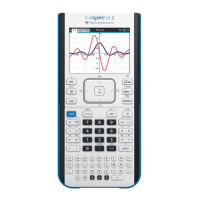236 Using Lists & Spreadsheet
where: [Lbnd,Ubnd]=lower and upper limits
The Ü-statistic is used as the bound producing the smallest integral. The
remaining bound is selected to achieve the preceding integral’s equality
relationship.
LinRegTTest
LinRegTTest (linear regression t test) computes a linear regression on the
given data and a t test on the value of slope b and the correlation
coefficient r for the equation y=a+bx. It tests the null hypothesis H
0
: b=0
(equivalently, r=0) against one of the alternatives below.
•H
a
: bƒ0 and rƒ0 (b & r:ă0)
•H
a
: b<0 and r<0 (b & r:<0)
•H
a
: b>0 and r>0 (b & r:>0)
Multiple Reg Tests (MultRegTest)
Multiple linear regression t test computes a linear regression on the
given data, and provides the F test statistic for linearity.
Refer to the TI-Nspire Reference Guide for information about
MultRegTests.
ANOVA
ANOVA (one-way ANalysis Of VAriance) computes a one-way analysis of
variance for comparing the means of two to 20 populations. The
ANOVA
procedure for comparing these means involves analysis of the variation
in the sample data. The null hypothesis H
0
: m
1
=m
2
=...=m
k
is tested against
the alternative H
a
: not all m
1
...m
k
are equal.
The ANOVA test is a method of determining if there is a significant
difference between the groups as compared to the difference occurring
within each group.
This test is useful in determining if the variation of data from sample-to-
sample shows a statistically significant influence of some factor other
than the variation within the data sets themselves. For example, a box
buyer for a shipping firm wants to evaluate three different box
manufacturers. He obtains sample boxes from all three suppliers. ANOVA
can help him determine if the differences between each sample group
are significant as compared to the differences within each sample group.
ANOVA 2-way (ANOVA2way)
ANOVA 2-way computes a two-way analysis of variance for comparing
the means of two to 20 populations. A summary of results is stored in the
stat.results variable.

